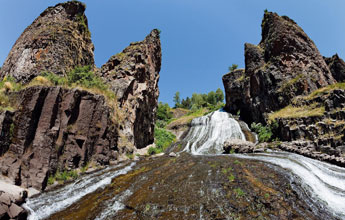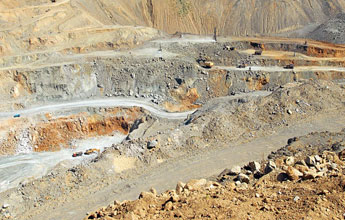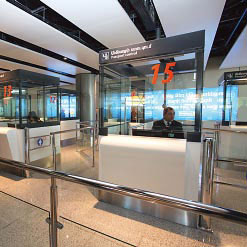Regional Position
Armenia is located in the Southwest Caucasus region, at the crossroads of Europe and Asia. It is a landlocked country bordered by Georgia to the north, Azerbaijan to the east, Iran to the south, and Turkey to the west.
Armenia’s land area is 29,800 square kilometers (11,505 square miles), and the population is 3.3 million. The maximum distance from north to south is 360 kilometers, and from east to west 200 kilometers. About fve percent of the country’s territory is covered by lakes, the biggest of which is Lake Sevan. Armenia’s borders with Turkey and Azerbaijan have been closed since the 1990s due to the Nagorno-Karabakh confict. Automobile roadways and railways via Georgia and Iran are the principal land routes to/from the country, and the aviation system features extensive international network coverage (for more details see the Flight Connectivity section of the Guide). The nearest seaport is Poti in Georgia, through which Armenia has access to the countries of the Black Sea region.
The new railroad project connecting Armenia to Iran will provide routes all the way out to the Persian Gulf, providing access to neighboring Central Asia, the Middle East, India and China. Currently the railway network extends northwest to Port Poti in Georgia. Armenia also has a highway with Iran.
Climate
 Armenia has a tremendously diverse climate for a relatively small geographical area, from the sunny Ararat valley with its bountiful fruit gardens, to the snowcapped mountain ranges that serrate the land. Several microclimates exist because of the country's mountainous terrain. A sunny and hot day in the Ararat Valley may at the same time feature quite brisk weather near the windswept mountainous lakes, and snow may fall in the upper regions of Mount Aragats. The rolling hills and high fats seem sculpted especially for rugged cross-country skiing in the winter, while Lake Sevan in the summertime is a wonderful destination for swimming, sunbathing, and relaxation.Average temperatures in the country's capital, Yerevan, range from -5oC in winter to 30oC in summer, although the thermometer may fall to -10oC and rise to over 40oC. Average precipitation ranges from less than 12 inches per year in the lower Arax river valley to about 36 inches per year at the highest altitudes. In Armenia, an average of 280 days a year are sunny.
Armenia has a tremendously diverse climate for a relatively small geographical area, from the sunny Ararat valley with its bountiful fruit gardens, to the snowcapped mountain ranges that serrate the land. Several microclimates exist because of the country's mountainous terrain. A sunny and hot day in the Ararat Valley may at the same time feature quite brisk weather near the windswept mountainous lakes, and snow may fall in the upper regions of Mount Aragats. The rolling hills and high fats seem sculpted especially for rugged cross-country skiing in the winter, while Lake Sevan in the summertime is a wonderful destination for swimming, sunbathing, and relaxation.Average temperatures in the country's capital, Yerevan, range from -5oC in winter to 30oC in summer, although the thermometer may fall to -10oC and rise to over 40oC. Average precipitation ranges from less than 12 inches per year in the lower Arax river valley to about 36 inches per year at the highest altitudes. In Armenia, an average of 280 days a year are sunny.
Natural Resources
 Armenia is a mountainous country, and therefore rich in mineral resources such as iron, copper, molybdenum, lead, zinc, gold, silver, antimony, aluminum, as well as other scarce and hard-to-fnd metals. Iron and copper ore, especially, are exported in signifcant volume.More than 670 solid mineral mines, including 30 metal mines, are currently registered in the state inventory of mineral resources. About 400 of these are exploited, including 22 metal mines: Seven copper-molybdenum mines, four copper mines (operated in the southern part of the country in Kadjaran, Dastakert and Agarak), 14 gold mines (operated in Sodq and Meghradzor) and gold-poly-metallic mines, two poly-metallic mines, two iron ore mines, and one aluminum mine. Armenia's territory is divided into three zones with metal deposits: Alaverdi-Kapan, Pambak-Zangezur and Sevan-Amasia.Armenia also possesses some of the world’s most diverse non-metallic minerals, including almost all types of mineral rocks. Other resources such as tuff, perlite, pumice-stone, zeolite, scoria, basalts, granites, nephelite syenite, and marble are widely used in construction. Non-metallic mines for minerals such as quartzite, carbonate, zeolite, scoria and pumice-stone, clay, bentonite, diatomite, and gypsum, also comprise a signifcant part of Armenia’s mining sector.Armenia is rich in mineral water as well. The cities of Jermuk, Dilijan, Bjni, Arzni, Hankavan, and Sevan are well known in the world for both the medicinal and organoleptic qualities of their waters.
Armenia is a mountainous country, and therefore rich in mineral resources such as iron, copper, molybdenum, lead, zinc, gold, silver, antimony, aluminum, as well as other scarce and hard-to-fnd metals. Iron and copper ore, especially, are exported in signifcant volume.More than 670 solid mineral mines, including 30 metal mines, are currently registered in the state inventory of mineral resources. About 400 of these are exploited, including 22 metal mines: Seven copper-molybdenum mines, four copper mines (operated in the southern part of the country in Kadjaran, Dastakert and Agarak), 14 gold mines (operated in Sodq and Meghradzor) and gold-poly-metallic mines, two poly-metallic mines, two iron ore mines, and one aluminum mine. Armenia's territory is divided into three zones with metal deposits: Alaverdi-Kapan, Pambak-Zangezur and Sevan-Amasia.Armenia also possesses some of the world’s most diverse non-metallic minerals, including almost all types of mineral rocks. Other resources such as tuff, perlite, pumice-stone, zeolite, scoria, basalts, granites, nephelite syenite, and marble are widely used in construction. Non-metallic mines for minerals such as quartzite, carbonate, zeolite, scoria and pumice-stone, clay, bentonite, diatomite, and gypsum, also comprise a signifcant part of Armenia’s mining sector.Armenia is rich in mineral water as well. The cities of Jermuk, Dilijan, Bjni, Arzni, Hankavan, and Sevan are well known in the world for both the medicinal and organoleptic qualities of their waters.
































 Regional Position, Climate and Natural Resources
Regional Position, Climate and Natural Resources